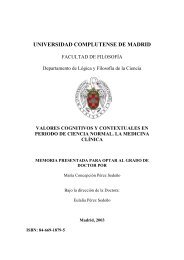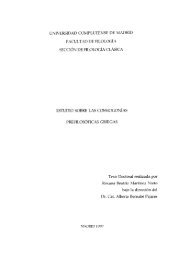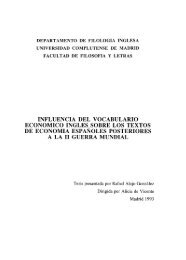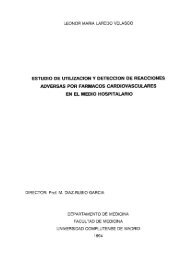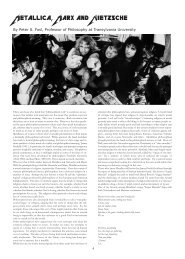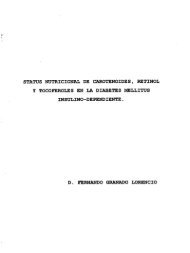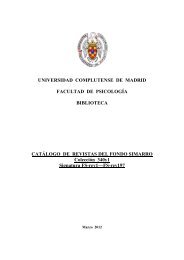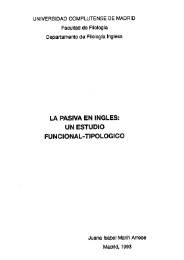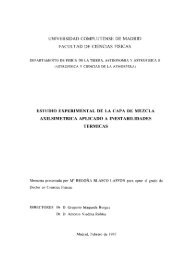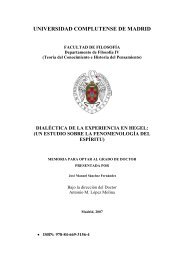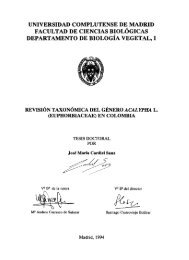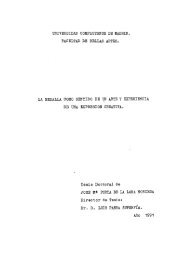- Page 1 and 2:
ABRIR PUNTO 22
- Page 3 and 4:
y me quiero casar con el mejor mozu
- Page 5 and 6:
1548 1491 ¡Oh! Virgen de Covadonga
- Page 7 and 8:
1550 1495 San Antonio bendito, tres
- Page 9 and 10:
1552 1499 Tengo un mandilin en casa
- Page 11 and 12:
1554 1503 Last night 0w dogs did ba
- Page 13 and 14:
1556 1 505 Madre, quiérome casar,
- Page 15 and 16:
1558 1507 Here’s my sister Betsy,
- Page 17 and 18:
1560 1 >ieard of a prophecy as spok
- Page 19 and 20:
1562 con el comentario de que la ap
- Page 21 and 22:
1564 1511 Si mi madre no me casa pa
- Page 23 and 24:
1566 rer casar corno la que recoge
- Page 25 and 26:
1568 1518 Por un pajecillo del corr
- Page 27 and 28:
1570 only saurce Por a Pulí versio
- Page 29 and 30:
1572 You nasty impudent jade, I’l
- Page 31 and 32:
1574 For he is so enticing, he bili
- Page 33 and 34:
1576 Tbere’s Charle>’, Alanzo a
- Page 35 and 36:
1578 ‘Oh, bush up, ¡ny daugliter
- Page 37 and 38:
1580 ’ sings) (Mar>’ speaks) (M
- Page 39 and 40:
1582 Y do not want no ccv an’ cal
- Page 41 and 42:
1584 1523 Soy viudita, lo manda la
- Page 43 and 44:
1524 Shaon, shaan, sboon with a roa
- Page 45 and 46:
1588 1528 Debajo del molino nació
- Page 47 and 48:
1590 1530 Un canaria aflegio ronda
- Page 49 and 50:
1592 1535 Mancebo casae commiga, qu
- Page 51 and 52:
594 1539 A £armer’s bo>’, a fa
- Page 53 and 54:
1541) Labrador ha.de ser, labrador
- Page 55 and 56:
CMPM, núm. 250, pág. Labradores
- Page 57 and 58:
1600 NNFSB, núm. 63, pág. 124. 15
- Page 59 and 60:
1602 1549 Soldadito lo quiero, aunq
- Page 61 and 62:
604 1552 Lo moreno lo hizo Dios, lo
- Page 63 and 64:
1606 Ny mcther ahe toid me te take
- Page 65 and 66:
1608 Ny motier sie teid me to light
- Page 67 and 68:
1610 Tíere vas an oíd man come ay
- Page 69 and 70:
1612 Att oid man be cernes creeping
- Page 71 and 72:
1614 Versión G: Versión R: He goe
- Page 73 and 74:
1616 1 votaid nat marry a farmer, H
- Page 75 and 76:
1618 Rich girí wears tbe rtaffle d
- Page 77 and 78:
1620 Att oíd man, an oíd man, an
- Page 79 and 80:
1622 1561 Todo el mundo me da vaya,
- Page 81 and 82:
1624 1566 Un sacristan me quiere y
- Page 83 and 84:
1626 CC, pág. 273, corrandes 1571
- Page 85 and 86:
628 TM, núm. 61, pág. 503. 1577 T
- Page 87 and 88:
¡630 1581 Tengo cuatro pañuelos t
- Page 89 and 90:
1632 Una rosa tengo en agua y la te
- Page 91 and 92:
1634 1591 En el lado derecbp de mi
- Page 93 and 94:
1636 OPEs, núm. 2102, tomo II, pá
- Page 95 and 96:
1638 So if 1 ven te climb a lofty o
- Page 97 and 98:
1640 1605 Santa Maria casarme quer
- Page 99 and 100:
1642 23.3 No Quiere Ser Monja 1609
- Page 101 and 102:
644 1612 Ser quiero, madre, señora
- Page 103 and 104:
1646 1614 Aunque me vedes morenica
- Page 105 and 106:
1 648 “Infeliz, más me hubiera v
- Page 107 and 108:
1650 me cortaba Llores, te las daba
- Page 109 and 110:
1652 1 love to hear men flattering,
- Page 111 and 112:
25 NO QUIERE CASAR 25.1 Quiere Ser
- Page 113 and 114:
1624 No quiero ser casada sino libr
- Page 115 and 116:
1628 1 don’t want to marry and be
- Page 117 and 118:
Bat oh, she kept sighing and solemn
- Page 119 and 120:
I’li riot marry a man tbat is poo
- Page 121 and 122:
1665 o como cuando se aPiade is est
- Page 123 and 124:
1 667 Véanse los núms. 1539 y 155
- Page 125 and 126:
INDICE DE PRIMEROS VERSOS DEL REPER
- Page 127 and 128:
1671 Adida puente de Tudela;
- Page 130 and 131:
1874
- Page 132 and 133:
1878
- Page 134:
1878
- Page 137 and 138:
(Cas.And> (Cas.And)
- Page 140:
1864 Heime de embarcar n—un barc
- Page 143 and 144:
(Ing)
- Page 145 and 146:
! pero no de Le. sardina,
- Page 147 and 148:
(Cas.And)
- Page 150 and 151:
1B94 (Hoz) (Cas.And>
- Page 152 and 153:
1898
- Page 154:
1698
- Page 157 and 158:
- Page 160 and 161:
1704
- Page 162:
1706
- Page 165 and 166:
LíRICA POPULAR DE PRIMERA PERSONA
- Page 167 and 168:
IIENSAYODECOMPARACIÓN CON LÍRICA
- Page 169 and 170:
5. RESULTADQSDELENSAYODECOMPARACIÓ
- Page 171 and 172:
VIII • Gritos 604 • Llamadas, a
- Page 173 and 174:
A PIA DICE II: LISTADEINFORMANTESYC
- Page 175 and 176:
3 INTRODUCCIÓN 1, QUÉ ES CANCIÓN
- Page 177 and 178:
2. ESTADO DE LA CUESrIóN 5 No es l
- Page 179 and 180:
7 Sr ncc iai ni~. fiuddhi st times,
- Page 181 and 182:
9 parciales como las nanas, las can
- Page 183 and 184:
II Mucho se ha dicho sobre lo popul
- Page 185 and 186:
13 tendremosquerecurriralaaplieaci
- Page 187 and 188:
15 Charles Francis Pottcr, por más
- Page 189 and 190:
i No hay que olvidar que sea etíal
- Page 191 and 192:
4. SOBREELMÉTODO It) Aunque hemos
- Page 193 and 194:
21 refiere a modos dc canción bien
- Page 195 and 196:
ENSAYO DE COMPARACIÓN CON LíRICA
- Page 197 and 198:
25 Hemos realizado una selección d
- Page 199 and 200:
27 En lenguas africanas (afroasiát
- Page 201 and 202:
29 2. LA LíRICA FEMENINA A ‘l’
- Page 203 and 204:
31 las Canfigasd’amigodosuvvadorc
- Page 205 and 206:
33 fueron recogidas y publicadasa f
- Page 207 and 208:
35 • cl Merodomiii ¡¿vcilissimo
- Page 209 and 210:
• Cancioneropopu/arg’a/lego(CPG
- Page 211 and 212:
39 • A la tradición húngara per
- Page 213 and 214:
4’ • 4 ejem plos de las tri bus
- Page 215 and 216:
43 estructuras son demasiado dispar
- Page 217 and 218:
45 4.1. DESCONCIERTO, INCERTIDUMBRE
- Page 219 and 220:
• Lca~e me alone’, ¡ salé, 4.
- Page 221 and 222:
49 SI flO q tic apa recen cci la l
- Page 223 and 224:
La india de (loa se siente desgraci
- Page 225 and 226:
y así sc Lamenta la viuda escocesa
- Page 227 and 228:
55 I-Iu u.vcj uen ge ngiseram! Pi (
- Page 229 and 230:
—Dic’u.t tau vi/a gran dan/mu
- Page 231 and 232:
5) así también, en estos versos d
- Page 233 and 234:
(~1 O’ lo the anns ofmny
- Page 235:
63 Ile clitt~ ! y de la tradición
- Page 238 and 239:
a) fl qgw le
- Page 240 and 241:
flzc kv~Is are nx¿síízxg oií Ih
- Page 242 and 243:
‘70 o en este can lo popular dc G
- Page 244 and 245:
72 4.4. LA LLAMADA, INVOCACIÓN YIO
- Page 246 and 247:
-74 o como lo hace la san tal í qu
- Page 248 and 249:
76 Dc Venczt¡ela procede el siguie
- Page 250 and 251:
78 Así, también, utí litando la
- Page 252 and 253:
SI kc’¡,v I~cune, ba¡ u, mih. b
- Page 254 and 255:
82 4.5. PROCLAMACIÓN DEL DESEO Y/O
- Page 256 and 257:
84 SI /¡flUCS : 38 José Maria Ali
- Page 258 and 259:
Yola trcasuu’c is colonrlul likc
- Page 260 and 261:
cama sola y sin companía porque el
- Page 262 and 263:
9) Dcsvc lo normal metilo prodítci
- Page 264 and 265:
92 Mencionemosaquítambién la canc
- Page 266 and 267:
94 4.7. SOLA (estos’ sola, sola s
- Page 268 and 269:
4.8. LA AUSENCIA Y/O EL ABANDONO Ot
- Page 270 and 271:
De tr-adicións inglesa contenipora
- Page 272 and 273:
Y tiene a su amante preso la muchac
- Page 274 and 275:
¡02 Ni un’ leíi’c,, ni ame pe
- Page 276 and 277:
¡04 A /¡e,re¡ que’ uen cite’
- Page 278 and 279:
It 16 4.8.4. EL AMAI)O SE FUE A LUG
- Page 280 and 281:
108 4.8.5. EL AMADO SE FUE Y LA 1-l
- Page 282 and 283:
¡ ¡o Sol a y’ abandonada q tíe
- Page 284 and 285:
¡12 y entre el repertorio musical
- Page 286 and 287:
Fucile llave ni 114 ¡ Quédatc con
- Page 288 and 289:
¡ 16 4.10. LA l)tiSl>EDI DA Y/O LA
- Page 290 and 291:
y las siguiente cancionei lías per
- Page 292 and 293:
120 4.11. EL RECHAZO O EL DESI>ECI-
- Page 294 and 295: 22
- Page 296 and 297: 24 Dcl reícrtori o ni usi cal cont
- Page 298 and 299: Ile>, stop piilliiig At ny bre-asts
- Page 300 and 301: ¡28 La india santalí, más despec
- Page 302 and 303: 3: Ich was ein chiat so wolgetan Vi
- Page 304 and 305: De la tradición gaélica proceded
- Page 306 and 307: ¡34 ¡liere ale plenty el utíer m
- Page 308 and 309: ¡3ñ Dc la región dc El Epiro, m
- Page 310 and 311: Un íxKt dc agila cii un \aS(1 deja
- Page 312: En el repertorio iii tísica! espit
- Page 315 and 316: 143 Pc» q¿u ti¡ El vituperio, el
- Page 317 and 318: ¿IP’> OK /1 ¡ P•O Xi ¡ £‘
- Page 319 and 320: Li> ¿‘Ip’ í¿¿iIIIÚX 147 y
- Page 321 and 322: 414 N1:¡~ ¡líe [¡pcdc’ ¡~tl
- Page 323 and 324: 151 y del repertorio musical col[te
- Page 325 and 326: [53 En la tradicion argendna tenemo
- Page 327 and 328: [55 Di la tradición norteafricana
- Page 329 and 330: - 1< S.%i~¡ ~.N 1 ~‘e,l. Quia ra
- Page 331 and 332: 159 Ven mo. ¡‘ Ci eimoi R, 136 <
- Page 333 and 334: 161 -1. [8. LA LLEG A l)A DEL A MA
- Page 335 and 336: [63 lA ¿lite ci mu el. (‘ii m ib
- Page 337 and 338: [65 4.19, LA INICIAlí VA: IR AL Ii
- Page 339 and 340: 167 N~lc íct¡íazé contigo u [os
- Page 341 and 342: O uííother mine, as shocuw¿kers
- Page 343: f”oénammíe a/niña,’ a orlas
- Page 347 and 348: 175 llicie idiliO udíng ihrce youn
- Page 349 and 350: 177 y en la turca (en la qt¡c se i
- Page 351 and 352: .1 épnu.íoi fi Itílin, [79 Falen
- Page 353 and 354: 1 it ‘¡si: 1 ti a. a lialz’ .
- Page 355 and 356: [83 [Desdeati u u y Izas la mi a n~
- Page 357 and 358: 185 ‘Vv cfi’ ,mím
- Page 359 and 360: lEY Fu ocasiones las ordenes o rtic
- Page 361 and 362: [89 Las ordeiles o ruegos del ti pu
- Page 363 and 364: 191 4.20, LO DEJA 0 1) EJe ‘lODO
- Page 365 and 366: [93 4,2 1 , l~íkRDl DAS ’; pcm
- Page 367 and 368: [95 A< ¡tic’ d dije ¡oil/e ceje
- Page 369 and 370: 197 c¡tIlCiOIl esta íie ¡los rec
- Page 371 and 372: [99 4.22. PR ES ILN’l’AC 1 eN I
- Page 373 and 374: 201 Dcl siglo XVI es tambien cl sig
- Page 375 and 376: 203 \Vas 1 n :: :í1~ [iitlic¡‘s
- Page 377 and 378: 205 01>,
- Page 379 and 380: 207 II 5OU could give incas a bride
- Page 381 and 382: 2¿’r¿.’ mit ‘a ¡ibaniñe
- Page 383 and 384: 211 ‘I’lntugli ¡líe w índow
- Page 385 and 386: 213 It is iiot 1 ~vlu~aííí al la
- Page 387 and 388: 215 y en ¡tal ia¡ o de Vi ¿ci:za
- Page 389 and 390: 217 Aud ~~-Iien 1 th:uik calmlv cii
- Page 391 and 392: 21’) 4.24. ‘l’EORIAS Y CONSEJ
- Page 393 and 394: y a tIodiL’ tensas; 221 yo ¡míe
- Page 395 and 396:
1)e la t rad it’ iOil po rt ti __
- Page 397 and 398:
225 y la siguienle (en la que apare
- Page 399 and 400:
227 4.26, LA 1 NGERIINCIA ) Las mur
- Page 401 and 402:
,uhm¡m¡ e mmze¿’ se beadím~
- Page 403 and 404:
231 Oh 1 cnt z cm/cm im’ ~-¿mm¡
- Page 405 and 406:
1, ogrc’di no¡t ¿mudea nec inpa
- Page 407 and 408:
235 En la siguiente cancion, perte.
- Page 409 and 410:
237 ¡ tt,i-s~ikt ng mv SX% cetíic
- Page 411 and 412:
239 y cix la tradición dc los Pi r
- Page 413 and 414:
en níx cancionero (leí siglo XIX
- Page 415 and 416:
Gr., asimismo, la siguientecanción
- Page 417 and 418:
245 dulce nadie, ¡lii puedo mimar
- Page 419 and 420:
247 y, anticipando, taníbic¡i, la
- Page 421 and 422:
)or it mmui.í 24Q fin’ sin colmq
- Page 423 and 424:
251 El .‘. ‘..~, m•I•fl le
- Page 425 and 426:
253 en csUt otra jarcha dc la serie
- Page 427 and 428:
255 4.29. QUI ERE AMOR. SE QUIERE C
- Page 429 and 430:
257 y quiere marido la siria ,¡tii
- Page 431 and 432:
259 He ~~Iuísils tipsusr¡s dr¡ri
- Page 433 and 434:
261 1 wi II ihícad ihe blussoiu An
- Page 435 and 436:
263 Don ‘¡¡lii íik ol splendou
- Page 437 and 438:
265 Te mc busca un esiudianle. ¿Te
- Page 439 and 440:
267 y en la seguidilla castellana,
- Page 441 and 442:
269 ¡‘/1 ¡¡oP ¡flO¡ 1% PíO
- Page 443 and 444:
271 Ja veza mmu>II Un labradores
- Page 445 and 446:
A Ii si j avai s les trdsors du siM
- Page 447 and 448:
275 -1 igha nno glí é un ¡a vau
- Page 449 and 450:
277 —Ivlaplíer, ¡ ,vauld nuzrrv
- Page 451 and 452:
que nos recuerda la recogida en Zam
- Page 453 and 454:
281 W hn slw II 1 sí ng lo 1hec, B
- Page 455 and 456:
283 (fi¡C ~‘alvaisníañana, que
- Page 457 and 458:
285 43 1. CELOSA cuando estés cot
- Page 459 and 460:
Od peul-il bien éi:c, Orand Dieu!
- Page 461 and 462:
289 Dámaso Alonso ya relacionó é
- Page 463 and 464:
291 Suzsera quemado i’u’ne Glif
- Page 465 and 466:
293 rasgos de esíJera y llegada de
- Page 467 and 468:
¡muais tau Ial clip, -czrje 1 czi
- Page 469 and 470:
297 En ¡a tradición inglesa tenem
- Page 471 and 472:
299 asícomo las canciones (más ar
- Page 473 and 474:
30! y sólo él la obtendrá (si to
- Page 475 and 476:
¡‘loe living ,,tan 11/ ¡ove aga
- Page 477 and 478:
305 Bright days sAmil turn to nighi
- Page 479 and 480:
307 Por vida de mis ojos. e/ca voll
- Page 481 and 482:
309 A la matina lo sen tu a sigolar
- Page 483 and 484:
311 Tite secds of tite pcpper plari
- Page 485 and 486:
313 y un gran caballero parece sere
- Page 487 and 488:
315 4.34. SE COMPLACE RECORDÁNDOLO
- Page 489 and 490:
Yé yé y¿ y¿
- Page 491 and 492:
319 4.35. REGALOS (le doy/daré/dar
- Page 493 and 494:
And to the third young man, 321 ¡
- Page 495 and 496:
323 Mañ Vil rneurt,je perds ma pei
- Page 497 and 498:
325 y, por fin ha conseguido la ind
- Page 499 and 500:
327 4.36. EL CAMBIO DE PARECER, HUM
- Page 501 and 502:
Bu: the A lmighty 329 Ant! he will
- Page 503 and 504:
Oh, he is gone, 331 He has tailcen
- Page 505 and 506:
333 baje una manta dc pena. ¡ Dios
- Page 507 and 508:
335 que se lamenta do tener que irs
- Page 509 and 510:
33.7 Y tanto pensaba en el amado qu
- Page 511 and 512:
339 y la estrofa (en latín) que ap
- Page 513 and 514:
Carretero, carretero, 341 ventejun
- Page 515 and 516:
343 e. Sobre la actitud de ira busc
- Page 517 and 518:
345 f. Sobre la actitud de ira coge
- Page 519 and 520:
347 y de la tradición inglesa o an
- Page 521 and 522:
y de no abrir recordemos el rechazo
- Page 523 and 524:
351 4.38. LAMENTO POR LA AUSENCIA O
- Page 525 and 526:
353 De las Islas Salomon es el sigu
- Page 527:
ABRIR PUNTO 5



